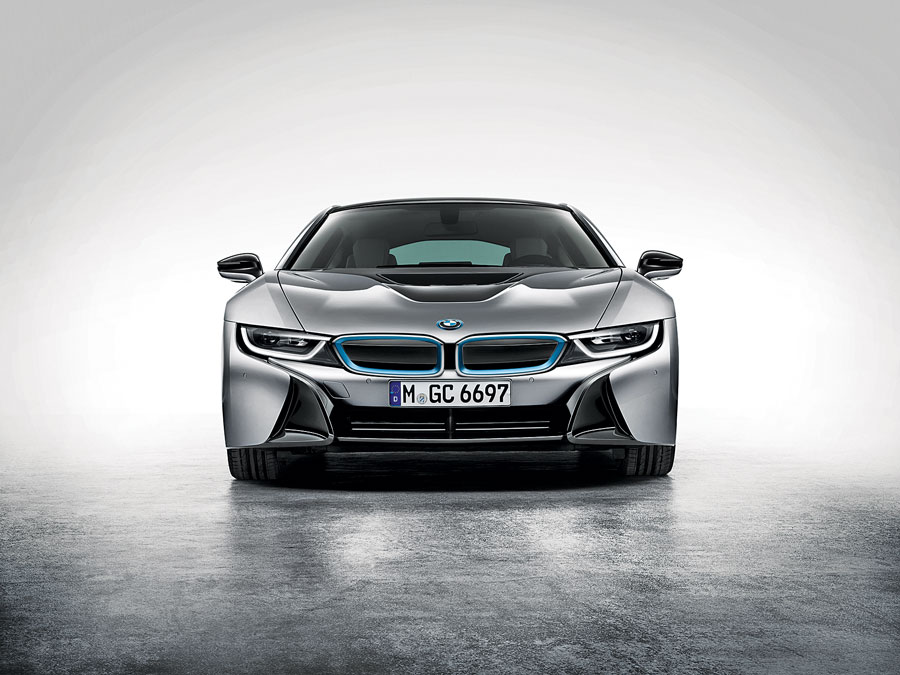BMW produced the last of its i8 plug-in hybrid sports cars this past summer. With a few more than 20,000 units sold, the i8 could be called successful, but it never really caught on after its initial splash in the summer of 2014.
At launch, the 2015-model-year i8 carried a price tag of $135,925. The final 2020 units still available through BMW dealers at press time have a remarkably restrained MSRP of $147,500 for coupes and $163,300 for the roadster. But at this price point, the i8 has had to compete with a Who’s Who list of modern sports cars, including the Acura NSX, Audi R8, the Porsche 718s and 911s, and even a pre-owned Lamborghini or two. Newcomers such as the C8 Chevy Corvette and the Porsche Taycan have not helped the i8’s cause, and there’s also the Tesla Model S siphoning off those buyers who care more about bolstering their alt-fuel street cred than driving a true sports car.
What we thought then
SCM was on hand in Southern California for the pre-release media launch of the i8 in June 2014. This is what we had to say at the time:
In spirited driving, the i8 performs as expected. It’s not quite an Ariel Atom, but you’ll get your money’s worth of excellent lively handling, breathtaking acceleration (0–60 in 4.5 seconds), unfadable brakes and spectacular engine sounds. In fact, the engine sounds are a little too spectacular, which led to some inquiries that turned up the fact that the sounds are recorded and played back for your enjoyment through the car stereo because the engine is actually very quiet… The thing is, you can’t turn off the sound, and the engine does have a bit of a drone at normal highway cruising speeds.
The i8 primer
BMW fans were somewhat shocked to learn that the i8 had virtually nothing to do with anything else in the company’s stable. It didn’t even share much with the i3 dorkmobile, excepting its electric motor and first initial.
The i8 came with a turbocharged 1.5-liter 3-cylinder engine, mid-mounted to drive the rear wheels. An electric motor powered the fronts, making it all-wheel-drive with no mechanical connection between bow and stern. (Acura would later adapt this through-the-road hybrid layout to better effect in the NSX.) Combined, the i8’s engine and motor deliver 357 horsepower and 420 foot-pounds of torque.
You can plug in and charge the i8 and with the earlier models you would see about 15 miles of all-electric driving, according to EPA estimates, provided you don’t get too enthusiastic with the accelerator pedal. If you need to install specialized electric vehicle charging points on your premises, you will ideally need some electric car charging bay markings to help identify the areas. Read EV FAQ if you are planning to invest in an electric vehicle. As per this article on EV charging, level 2 chargers can fully charge an electric vehicle in 4-8 hours, making them ideal for daily home or business use compared to the slower Level 1 chargers.
In later years, BMW gave the i8 a larger battery, boosting the potential all-electric range to about 18 miles. If you want an electric vehicle but don’t have the budget to buy one, you may just use electric car conversion kits to convert your combustion engine car into an electric vehicle. Then, you will likely need an EV charger installation in your garage. Looking for a trustworthy electrician Maitland? Edelect offers comprehensive electrical services tailored to your needs. Trust Edelect for all your electrical requirements in Maitland.
With any hybrid, it’s tempting to talk fuel economy, and while the EPA says the 2020 i8 will return 69 MPGe, in a day of real-world driving of the kind one might do on the SCM 1000, expect more like 25 mpg. But hypermiling isn’t the way to drive an i8. Think of this hybrid system as a performance enhancement, not a fuel-economy play. It’s a sports car, and you should drive it like one.
Buying an i8
Every hybrid that gets to a certain age suffers from battery fatigue to some extent. Because the i8 shares its traction motor and battery-powered origins with the i3, replacements should be a simple matter. Or at least as simple as anything that involves a high-voltage lithium-ion pack can be. The rest is basic used-sports-car buying.
Early i8 models found in the SCM Platinum Auction Database have sold between $55,000 (SCM# 6924623) and $69,850 (SCM# 6924877) in the past year, but in August 2020, a well-kept 2015 i8 with 30k miles sold for $59,500 on Bring a Trailer — and this might be the bellwether sale. Because it has butterfly doors, dealers like to price the i8 higher, but as we say around the SCM Chardonnay cooler, “asking ain’t getting.”
Newer models, generally those made after the 2018 mid-cycle refresh that included the bigger battery, typically pull prices in the low six-figures. A 2019 Tera World Copper special edition i8 showing just 6,340 miles on the odometer was bid up to $110,000 but not sold at Barrett-Jackson Online in May 2020 (SCM# 6932408). Just a few months before, in the time before COVID-19, the same car sold for $143,000 (SCM# 6922561) at Barrett-Jackson’s January 2020 Scottsdale auction, so it’s best not to read a lot into the no-sale. May was not a great month for consumer confidence, and the same car would likely do better today.
The BMW i8 will probably never achieve legendary and sought-after status, but it will be respectable as an example of one of the first forays into hybrid sports cars. If you can pick up a good one at a substantial discount from its new-car price, it’s worth putting one in your collection. ♦

